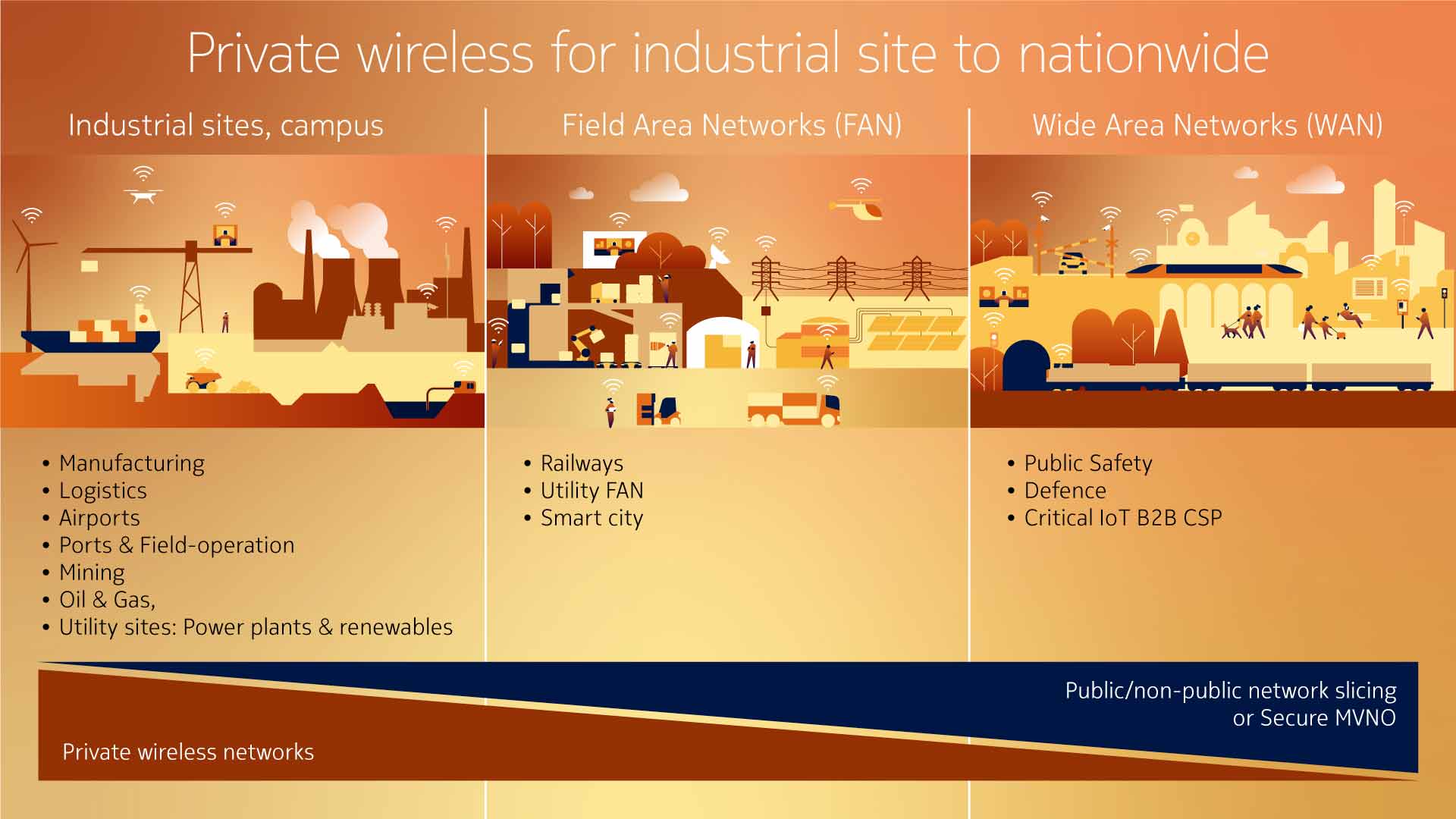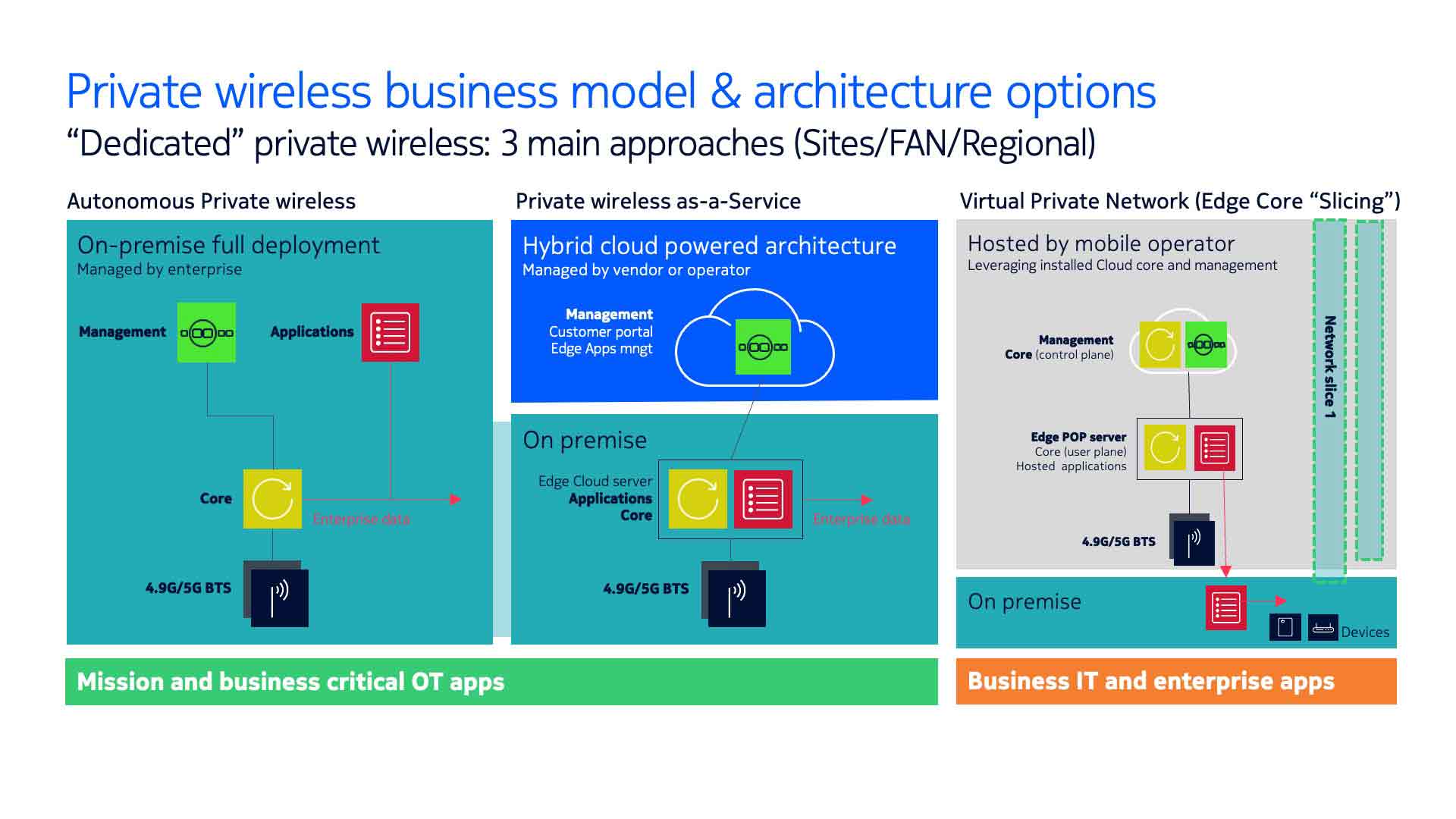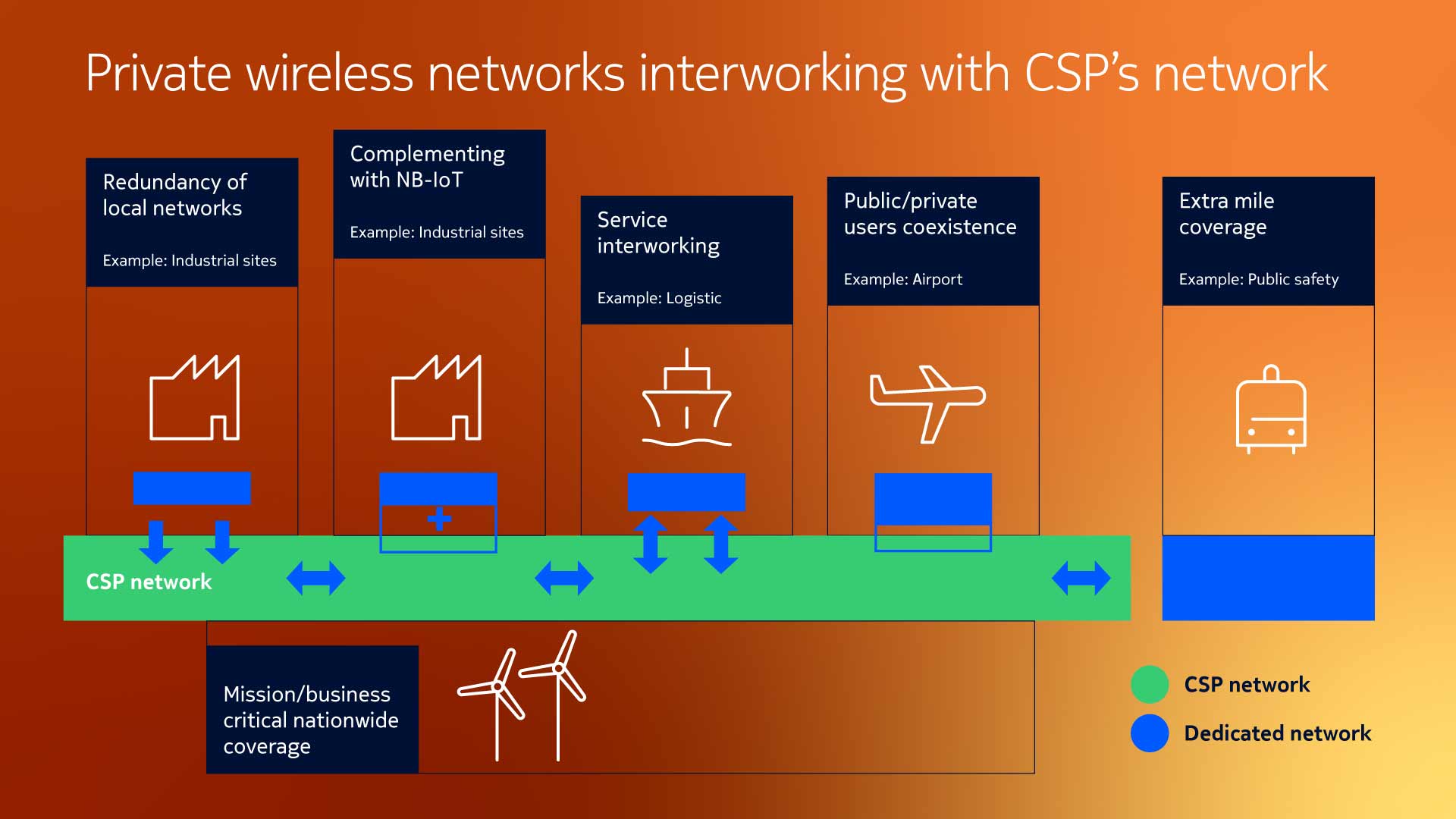Learn about industrial-grade private wireless
Power your digital transformation with a private 4.9G or 5G network
Private wireless: an overview
Take your business into the digital age with a private wireless network that delivers reliable, low-latency connectivity to every inch of your operations. Our industrial-grade private wireless solution will help you use digital technologies to increase automation, enhance safety and security, and achieve new levels of quality, efficiency and productivity.
Based on proven 4.9G and 5G technologies, industrial-grade private wireless is easy to deploy, is as robust and capable as Ethernet, and provides a smooth upgrade path to future 5G releases. It can digitally connect all your mission-critical operations in real time, no matter how fast the parts are moving. You can deploy it anywhere, use it to support your unique service needs, and rely on it to provide simple, robust plug-and-play networking.
What can you do using a private wireless network?
- Build a more agile business that can keep pace with shifting demand
- Accelerate your digital transformation
- Unlock new opportunities with the Internet of Things (IoT)
- Provide reliable connectivity to your people, machines and sensors
Benefits of private wireless?
How to implement private wireless?
Take your business into the digital age with a private wireless network that delivers reliable, low-latency connectivity to every inch of your operations. Our industrial-grade private wireless solution will help you use digital technologies to increase automation, enhance safety and security, and achieve new levels of quality, efficiency and productivity.
Based on proven 4.9G and 5G technologies, industrial-grade private wireless is easy to deploy, is as robust and capable as Ethernet, and provides a smooth upgrade path to future 5G releases. It can digitally connect all your mission-critical operations in real time, no matter how fast the parts are moving. You can deploy it anywhere, use it to support your unique service needs, and rely on it to provide simple, robust plug-and-play networking.
What can you do using a private wireless network?
- Build a more agile business that can keep pace with shifting demand
- Accelerate your digital transformation
- Unlock new opportunities with the Internet of Things (IoT)
- Provide reliable connectivity to your people, machines and sensors
Robust connectivity for Industry 4.0 and beyond
A private 4.9G or 5G wireless network can help you embrace Industry 4.0 and prepare for the future with robust and reliable connectivity for your people, machines and sensors together with new analytics capabilities to support all your essential operations.
The need for robust and reliable critical connectivity spans many Industry 4.0 use cases at industrial sites, plants and campuses, as well as for wide area network (WAN) deployments. To reliably support your mission-critical use cases, you need cost-effective private wireless solutions that provide dedicated connectivity at the right place and time.

Connecting your industrial campus: What are the benefits of deploying private wireless?
By deploying your own 4.9G/LTE or 5G private wireless network you gain the best possible coverage, capacity and connectivity for the mission-critical operations at your industrial sites whether your business is in manufacturing, logistics, transportation, mining, and energy or another sector. You decide which machines, sensors and workers are connected and can access the network and can prioritize support and performance in line with your unique service needs. When deployed with an industrial edge, you retain data governance, ensuring confidential data is processed on site safely and securely within your network.
Explore more on: DAC private wireless and Modular Private Wireless
Connecting wide area outdoor operations: Can my industry benefit from using shared public 4.9G/LTE or 5G networks?
If you are in the public safety, utility field area network (FAN), smart city or railway sectors you may want to leverage a shared public 4.9G/LTE or 5G network to achieve your critical WAN connectivity goals. Operator-owned public networks can typically prioritize mission-critical application traffic over normal, day-to-day communications.
IoT/critical connectivity communications service providers (CSPs) are seen as a new-generation CSP and many are deploying private regional or nationwide wireless networks for wide area IoT connectivity for the utilities, oil and gas or public safety sectors. These networks often support high-coverage, low-frequency bands such as 410 MHz, 450 MHz, 700 MHz and 900 MHz and offer another path to Industry 4.0.
Shared public wireless and IoT/critical connectivity CSP networks can also complement private wireless networks, through increased coverage, or by providing a back-up layer or support for additional use cases.
Explore more on: Mobile Broadband Transformation for public safety
Industrial-grade private wireless networks provide the next-generation connectivity you need to support your Industry 4.0 applications today and into the future.
Wi-Fi is well suited to supporting the day-to-day needs of IT services and can be adapted for industrial applications. But it offers limited reliability, security, predictability, multi-user capacity and mobility, all of which you need for your mission- and business-critical operational applications.
With industrial grade private wireless networks you can leverage proven 4.9G or 5G technology to meet the demands of all your mission-critical operational (OT) applications, supporting worker connectivity and safety, data analytics, predictive maintenance, automation and more.
|
Very high reliability |
Intrinsic security |
|
Pervasive coverage for indoor and outdoor applications |
Predictable performance |
|
High multi-user capacity |
Full mobility |
A private 4.9G or 5G wireless network is ideally suited for Industry 4.0 use cases deployed across many industry segments.
Build your custom solution
Multiple architecture and partnership options can be considered when implementing private wireless solutions. Choosing the best approach depends on multiple factors, including the characteristics of a site, the use cases you want to deploy and the level of expertise within your IT team.
Basic private wireless network architecture begins with the placement of radios around your site (or sites) to ensure optimum coverage and dedicated capacity. Those radios are then connected to the core, which will perform the network’s key functions. In a 4G/LTE cloud-native private network, an edge cloud server on your premises can perform some distributed core functions to improve latency and reliability, or to ensure data governance.
Given the flexibility in the distribution of core functions, there are several architecture deployment options. They range from a fully private, on-premises network to private wireless-as-a-service and core network slicing. Each option has strengths and weaknesses. Your unique needs and budget will determine which is the best fit for your business.

Autonomous private wireless
All network functions – core, management elements, applications – are deployed locally at your industrial site. If you need wireless services at more than one site, you can deploy all network functions at your headquarters and an application edge cloud at each site to improve reliability and latency.
An autonomous private wireless solution could be the right choice if you want full control of your operational technology (OT) network to ensure the reliability and availability of your local operations when failures occur in the outside world.
Private wireless as a service
All or most parts of the core and all applications are deployed on a local edge cloud server. The management elements are hosted in a third-party or mobile service provider’s cloud.
Private wireless as a service offers the perfect balance between performance, confidentiality, reliability, and operational simplicity
Core slicing
The minimum core elements and applications are deployed at your site to preserve confidentiality of your data. The remaining core elements run in the service provider’s cloud and rely on exiting cloud core management. This option is mainly suited for non-critical business IT and enterprise applications.
Communication Service Providers bring several key assets to the table. They have decades of experience of running wireless mobile networks and a long history with governments and regulators. This means they have experts and influencers that can help you get your project off the ground, and they hold licenses for spectrum that may be better suited for your specific applications than non-licensed or lightly licensed spectrum. Should you want to know more about the role that CSPs can play, read the white paper

For specific industrial use cases the interworking between your private wireless network and public mobile networks can also deliver key benefits such as supporting network redundancy or expanding reach and efficiency.

Licensed (vertical or CSP leasing) spectrum
Regulatory bodies around the world are increasingly releasing enterprise licenses for specific frequency bands. Many countries have now issued spectrum bands (2.6GHz TD-LTE, 3.7GHz, etc) for private wireless.
Nokia has agreements with several CSP partners to utilize some of their spectrum for private wireless deployments. Spectrum can be requested on an ad-hoc basis or as part of a CSP’s own private wireless offering.
Higher frequency bands tend to be used for private wireless deployments at industrial sites as they provide the right mix of capacity and coverage. Wide area private networks tend to favor lower spectrum for segments such as public safety, utility or railways (410-900Mhz)
Shared spectrum
The US leads the way in shared spectrum, with the Citizen Band Radio Service (CBRS) in the 3.5Ghz band. This is shared by incumbent, Priority Access License (PAL) and General Authorized Access (GAA) users. To use the CBRS band, GAA users can submit a request via the cloud-based spectrum access system (SAS) and this tends to be more applicable for site specific coverage. PAL users gain this status by purchasing licenses from the FCC for wider deployments.
Many countries are looking at similar shared spectrum models going forward.
Unlicensed spectrum
The 5GHz, 6GHz and 60GHz license-free spectrum bands have opened new opportunities for industries and the public sector to deploy private wireless networks.
The benefits of unlicensed spectrum include easy access and reduced cost as there’s no need to acquire spectrum or rights to it. Consequently, it allows enterprises to deploy private wireless networks in markets where spectrum is scarce, for example where local CSPs don’t sub-lease their spectrum.
Enterprises can augment their private wireless networks, for example adding capacity using unlicensed spectrum for high data uplink use cases such as video applications. It is also particularly suitable for new nomadic use cases such as events, construction, broadcasting, etc.
Industry-first private wireless TCO calculator
Accelerate digital transformation and optimize your TCO! Compare wireless connectivity network scenarios by simulating your industry site.
Please complete the form below.
The form is loading, please wait...
From now to next
Nokia Industrial-grade Private Wireless is powering Industry 4.0 today — and the 5G revolution tomorrow.